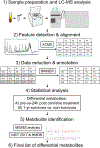Untargeted Metabolomics Differentiates l-Carnitine Treated Septic Shock 1-Year Survivors and Nonsurvivors
- PMID: 30895797
- PMCID: PMC6501183
- DOI: 10.1021/acs.jproteome.8b00774
Untargeted Metabolomics Differentiates l-Carnitine Treated Septic Shock 1-Year Survivors and Nonsurvivors
Abstract
l-Carnitine is a candidate therapeutic for the treatment of septic shock, a condition that carries a ≥40% mortality. Responsiveness to l-carnitine may hinge on unique metabolic profiles that are not evident from the clinical phenotype. To define these profiles, we performed an untargeted metabolomic analysis of serum from 21 male sepsis patients enrolled in a placebo-controlled l-carnitine clinical trial. Although treatment with l-carnitine is known to induce changes in the sepsis metabolome, we found a distinct set of metabolites that differentiated 1-year survivors from nonsurvivors. Following feature alignment, we employed a new and innovative data reduction strategy followed by false discovery correction, and identified 63 metabolites that differentiated carnitine-treated 1-year survivors versus nonsurvivors. Following identification by MS/MS and database search, several metabolite markers of vascular inflammation were determined to be prominently elevated in the carnitine-treated nonsurvivor cohort, including fibrinopeptide A, allysine, and histamine. While preliminary, these results corroborate that metabolic profiles may be useful to differentiate l-carnitine treatment responsiveness. Furthermore, these data show that the metabolic signature of l-carnitine-treated nonsurvivors is associated with a severity of illness (e.g., vascular inflammation) that is not routinely clinically detected.
Keywords: liquid chromatography−mass spectroscopy; pharmacometabolomics; vascular inflammation.
Figures



Similar articles
-
Application of LC-MS-based metabolomics method in differentiating septic survivors from non-survivors.Anal Bioanal Chem. 2016 Nov;408(27):7641-7649. doi: 10.1007/s00216-016-9845-9. Epub 2016 Sep 10. Anal Bioanal Chem. 2016. PMID: 27614981
-
Pharmacometabolomics of l-carnitine treatment response phenotypes in patients with septic shock.Ann Am Thorac Soc. 2015 Jan;12(1):46-56. doi: 10.1513/AnnalsATS.201409-415OC. Ann Am Thorac Soc. 2015. PMID: 25496487 Free PMC article. Clinical Trial.
-
Septic Shock Nonsurvivors Have Persistently Elevated Acylcarnitines Following Carnitine Supplementation.Shock. 2018 Apr;49(4):412-419. doi: 10.1097/SHK.0000000000000997. Shock. 2018. PMID: 29384504 Free PMC article.
-
The supplementation of L-carnitine in septic shock patients: Systematic review and meta-analysis.Clinics (Sao Paulo). 2022 Oct 31;77:100124. doi: 10.1016/j.clinsp.2022.100124. eCollection 2022. Clinics (Sao Paulo). 2022. PMID: 36327640 Free PMC article.
-
L-carnitine: Searching for New Therapeutic Strategy for Sepsis Management.Curr Med Chem. 2022;29(18):3300-3323. doi: 10.2174/0929867328666211117092345. Curr Med Chem. 2022. PMID: 34789120 Review.
Cited by
-
Patient Stratification in Sepsis: Using Metabolomics to Detect Clinical Phenotypes, Sub-Phenotypes and Therapeutic Response.Metabolites. 2022 Apr 21;12(5):376. doi: 10.3390/metabo12050376. Metabolites. 2022. PMID: 35629881 Free PMC article. Review.
-
Saikogenin A improves ethanol-induced liver injury by targeting SIRT1 to modulate lipid metabolism.Commun Biol. 2024 Nov 21;7(1):1547. doi: 10.1038/s42003-024-07234-x. Commun Biol. 2024. PMID: 39572758 Free PMC article.
-
Past Experiences for Future Applications of Metabolomics in Critically Ill Patients with Sepsis and Septic Shocks.Metabolites. 2021 Dec 21;12(1):1. doi: 10.3390/metabo12010001. Metabolites. 2021. PMID: 35050123 Free PMC article. Review.
-
Longitudinal NMR Based Serum Metabolomics to Track the Potential Serum Biomarkers of Septic Shock.Nanotheranostics. 2023 Jan 1;7(2):142-151. doi: 10.7150/ntno.79394. eCollection 2023. Nanotheranostics. 2023. PMID: 36793353 Free PMC article.
-
Using l-Carnitine as a Pharmacologic Probe of the Interpatient and Metabolic Variability of Sepsis.Pharmacotherapy. 2020 Sep;40(9):913-923. doi: 10.1002/phar.2448. Epub 2020 Aug 10. Pharmacotherapy. 2020. PMID: 32688453 Free PMC article.
References
-
- Singer M; Deutschman CS; Seymour CW; Shankar-Hari M; Annane D; Bauer M; Bellomo R; Bernard GR; Chiche JD; Coopersmith CM; Hotchkiss RS; Levy MM; Marshall JC; Martin GS; Opal SM; Rubenfeld GD; van der Poll T; Vincent JL; Angus DC, The Third International Consensus Definitions for Sepsis and Septic Shock (Sepsis-3). JAMA 2016, 315 (8), 801–10. - PMC - PubMed
-
- Langley RJ; Tsalik EL; van Velkinburgh JC; Glickman SW; Rice BJ; Wang C; Chen B; Carin L; Suarez A; Mohney RP; Freeman DH; Wang M; You J; Wulff J; Thompson JW; Moseley MA; Reisinger S; Edmonds BT; Grinnell B; Nelson DR; Dinwiddie DL; Miller NA; Saunders CJ; Soden SS; Rogers AJ; Gazourian L; Fredenburgh LE; Massaro AF; Baron RM; Choi AM; Corey GR; Ginsburg GS; Cairns CB; Otero RM; Fowler VG Jr.; Rivers EP; Woods CW; Kingsmore SF, An integrated clinico-metabolomic model improves prediction of death in sepsis. Sci Transl Med 2013, 5 (195), 195ra95. - PMC - PubMed
-
- Neugebauer S; Giamarellos-Bourboulis EJ; Pelekanou A; Marioli A; Baziaka F; Tsangaris I; Bauer M; Kiehntopf M, Metabolite Profiles in Sepsis: Developing Prognostic Tools Based on the Type of Infection. Crit Care Med 2016, 44 (9), 1649–62. - PubMed
Publication types
MeSH terms
Substances
Grants and funding
LinkOut - more resources
Full Text Sources

